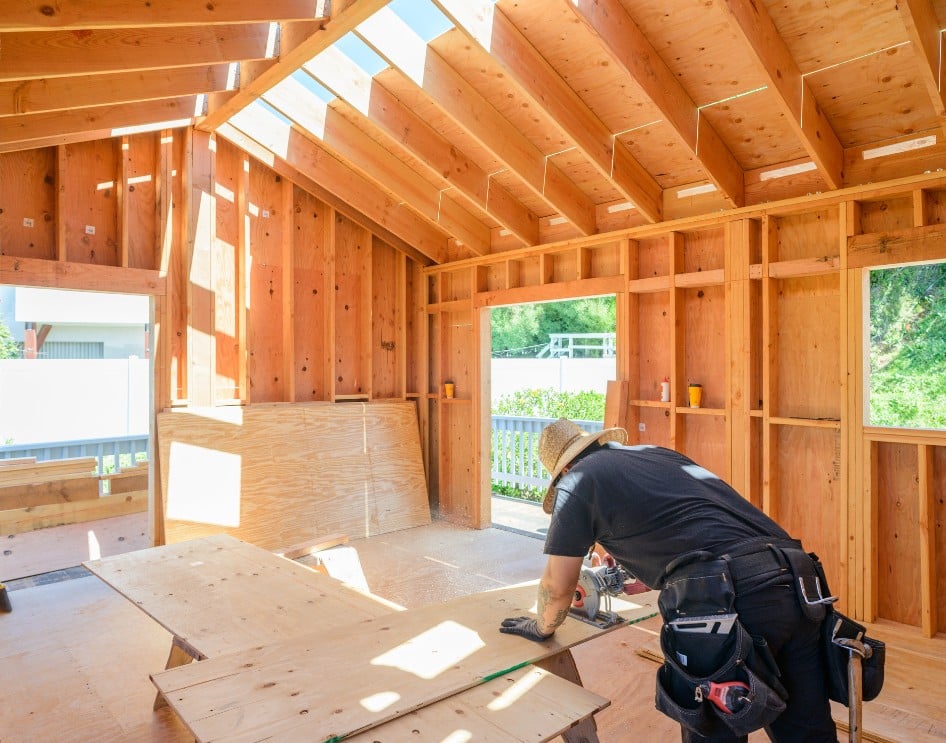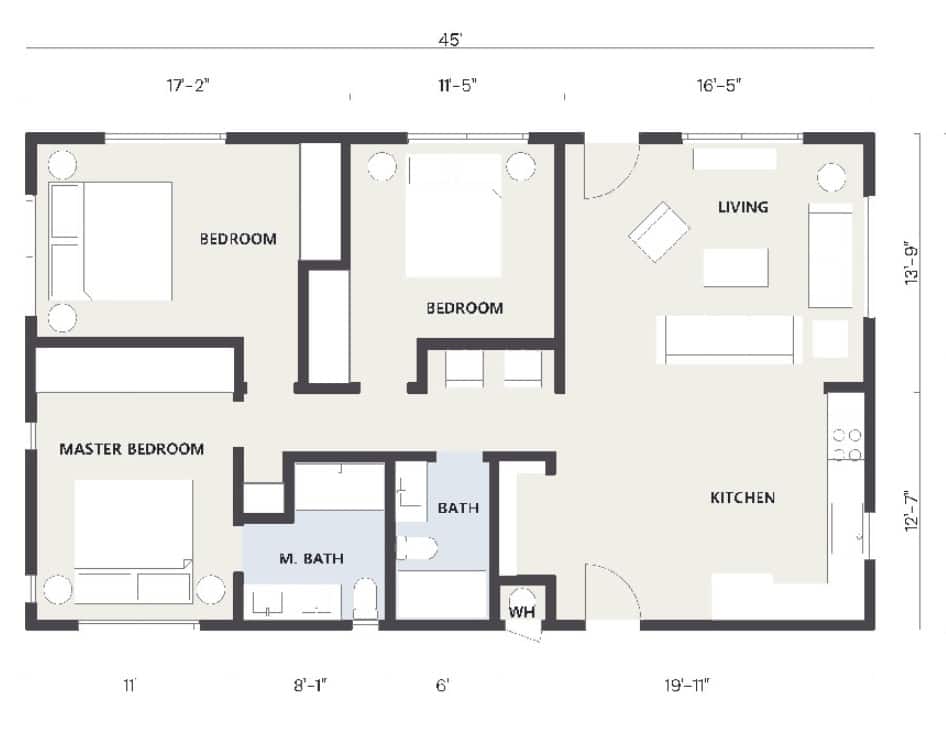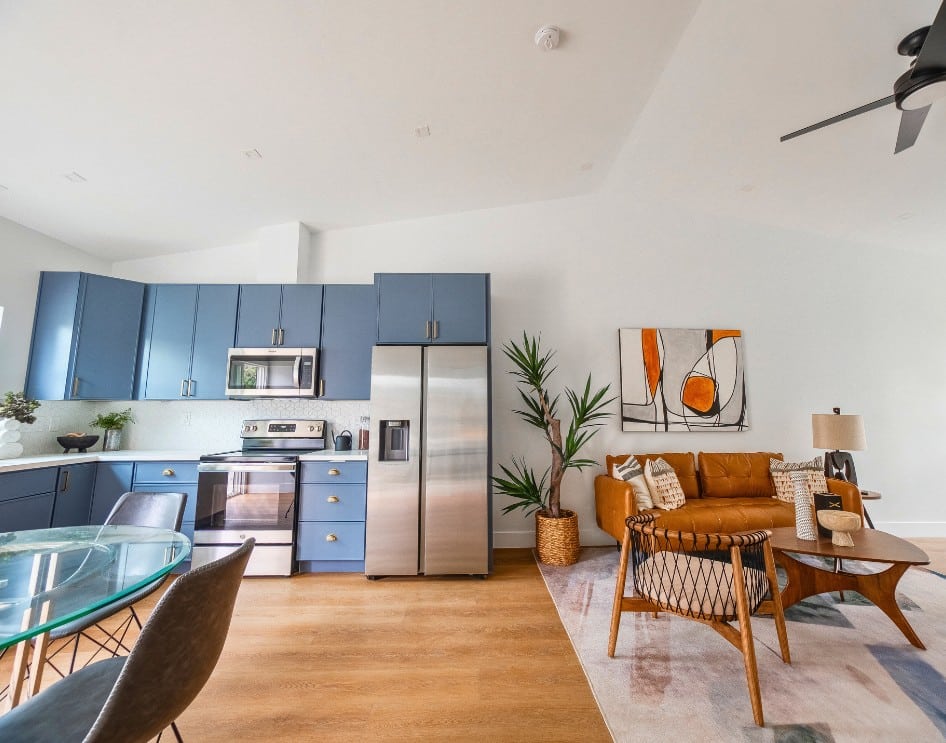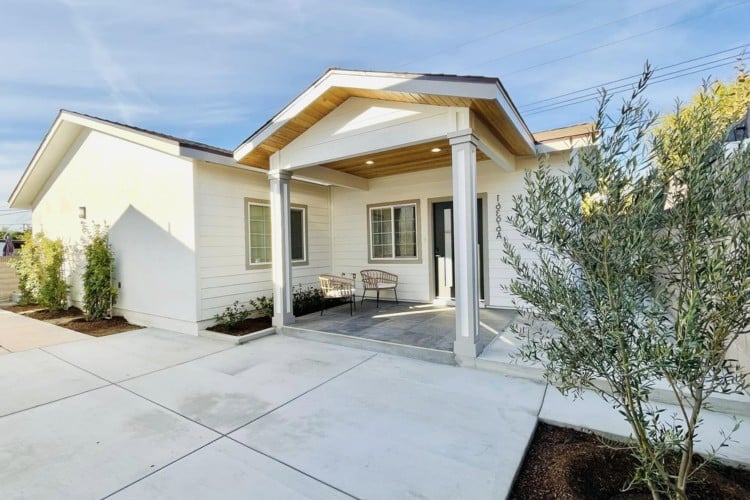Uncovering the Truth Behind 15 Common Misconceptions About Accessory Dwelling Units – ADUs
52 min read
Discover the truth behind common misconceptions about Accessory Dwelling Units (ADUs) and learn how to navigate the complexities of construction, costs, and regulations to make informed decisions for your property.

Introduction
Accessory Dwelling Units (ADUs) have become increasingly popular as a flexible and cost-effective way to add living space or generate rental income. However, several common misconceptions about ADUs can lead to confusion and misinformed decisions. It’s time to debunk these misconceptions so homeowners can make informed choices when considering an ADU project.
Misconception 1: ADU Cost Per Square Foot is a Reliable Metric
While cost per square foot is a common metric in the construction industry, it can be misleading when applied to ADUs. This metric often fails to account for the unique aspects of ADU construction.
Impact of Fixed Costs on ADU Projects
ADUs, being smaller in size, have fixed costs that significantly impact the budget for these additional housing units.
These fixed costs include:
- Permits Obtaining the necessary permits is crucial in the ADU process. These costs are generally fixed and do not vary with the unit size.
- Planning Fees Planning fees for site-specific adjustments, design approval, and compliance with local regulations add a significant expense to the project.
- Utility Hookups Connecting utilities such as water, electricity, and sewage to an ADU involves substantial costs that are not dependent on the size of the unit.
Custom features and high-quality interior finishes to maximize space further increase costs, making the cost per square foot appear disproportionately high. For instance, high-quality materials, compact yet efficient kitchen and bathroom fixtures, and custom cabinetry tailored to small spaces can drive up costs. Additionally, fixed costs like permitting and utility hookups do not scale down with the size of the dwelling, resulting in a higher cost per square foot compared to larger homes.
While cost per square foot is a helpful metric for estimating expenses, it does not provide an accurate picture of the total investment required for ADU construction. Homeowners should consider the total cost, factoring in these fixed and often significant expenses, to get a realistic understanding of their budget.
Misconception 2: Pre-Approved Plans are Always Cheaper and Faster
Pre-approved ADU plans are created to be quick and cost-effective solutions, but they come with their own challenges and misconceptions about pre-approved ADU floor plans.
Site-Specific Adjustments and Pre-Approved ADU Plans
Even with pre-approved plans, homeowners must navigate various site-specific adjustments that can negate the initial cost and time savings. These adjustments include:
- Compliance with Local Energy Standards ADUs must meet Title 24 energy efficiency standards in California. This involves detailed energy calculations and possibly upgrading insulation, windows, and HVAC systems to comply with stringent efficiency requirements.
- Creating Site Plans Every property is unique, and pre-approved plans must be adapted to fit the specific site. This includes designing site plans considering existing structures, landscaping, and utility connections.
- Topographical and Soil Considerations The specific characteristics of the land, such as slope and soil stability, can affect the foundation and overall construction approach, leading to additional costs.
- Utility Connections Ensuring the ADU is properly connected to water, electricity, and sewage systems can be complex and expensive, particularly if the property requires significant modifications to accommodate these connections.
- Local Zoning Compliance While pre-approved plans streamline some aspects of the permitting process, they still need to be checked against local zoning laws and setbacks, which can vary significantly between jurisdictions.
Benefits and Limitations of Pre-Approved ADU Plans
Benefits
- Expedited Permitting Pre-approved plans can shorten the time required to obtain building permits, as they have already been reviewed for compliance with building codes.
- Reduced Design Costs Homeowners save on design and architectural fees since these plans are typically less expensive than custom designs.
- Streamlined Approval Process Pre-approved plans can simplify interactions with local building departments and smooth the approval process.
Limitations
- Customization Restrictions Any modifications to pre-approved plans, even minor ones like moving a window, can void the pre-approval and require a full review, eliminating the time and cost savings.
- Hidden Costs The need for site-specific adjustments and additional compliance requirements can add unexpected costs, making the overall project more expensive than initially anticipated.
- Suitability Pre-approved plans may not be suitable for all properties, especially those with unique site conditions or specific homeowner needs that require customization.
Misconception 3: Owner Occupancy is Required
To address any concerns homeowners may have regarding living requirements, it’s important to know that this is not always the case.
California’s Owner Occupancy Waiver
To address the housing crisis, California has waived the owner occupancy requirement for ADUs for permits issued before 2025. This waiver allows homeowners to rent out the main house and the ADU, providing greater flexibility and potential rental income.
Key Points of the Waiver
- Temporary Waiver Valid until January 1, 2025, encouraging more ADU construction.
- Increased Flexibility Homeowners can rent both units independently, enhancing investment potential.
- Boosting ADU Numbers Reduced restrictions aim to increase the number of ADUs.
Junior ADUs (JADUs) and Owner Occupancy
JADUs still require owner occupancy, meaning the homeowner must live in either the main house or the JADU.
Specifics for JADUs
- Owner Occupancy Required to ensure proper oversight.
- Smaller Size Typically up to 500 square feet within the main house.
- Family Use Often used for family members, justifying the occupancy requirement.
Understanding Specific Regulations
Local regulations cannot prohibit the construction of ADUs if state laws allow them, so it’s crucial to understand both state and local rules.
Considerations
- Local Zoning Laws There may be additional requirements.
- Permitting Process Navigate state and local design, parking, and fees requirements.
- Long-Term Implications Knowledge of regulations helps in making informed property investment decisions.
Benefits of the Waiver
- Increased Rental Income Ability to rent both units.
- Flexibility Homeowners can rent out their property without occupancy restrictions.
- Encouraging Development Easier regulations promote ADU construction, addressing housing shortages.
Misconception 4: ADUs Lead to Overcrowding and Decrease Property Values
Some believe ADUs contribute to overcrowding and decrease property values, but this is not necessarily true.
Do ADUs Cause an Increase in Property Values?
Contrary to the belief that ADUs are bad, well-designed ADUs can actually increase property values. Usually, it’s close to 30%, but sometimes it can be 40% or higher. This increase in value is fueled by adding rentable space and enhancing the overall utility of the property. Rather than leading to overcrowding, ADUs provide much-needed housing solutions, offering flexibility when people move into changing living situations without negatively impacting the environment or neighborhood character.
Benefits of ADUs on Property Values
- Additional Living Space ADUs add extra square footage, making the property more attractive to potential buyers.
- Rental Income Homeowners can generate additional income by renting out the ADU, increasing the property’s value.
- Versatility ADUs can serve various purposes, such as housing large families or being used as home offices.
Addressing Overcrowding Concerns
While it’s understandable that some worry about overcrowding, ADUs typically house one or two people, causing minimal impact on neighborhood density.
- Controlled Density Increase ADUs lead to a slight, manageable increase in population density.
- Small Footprint The average ADU is around 600 square feet, housing only a few occupants.
- Preserving Neighborhood Character ADUs are designed to blend with existing homes, maintaining the neighborhood’s aesthetic appeal.
Enhancing Neighborhood Value
Contrary to the misconception, ADUs can enhance neighborhood value and livability.
Positive Impacts
- Increased Property Values Studies show that properties with ADUs often significantly increase in value.
- Diverse Housing Options ADUs provide affordable housing solutions, attracting diverse residents.
- Improved Utilization ADUs make better use of existing properties, reducing urban sprawl.
Considerations for Homeowners
- Design Quality Invest in high-quality design and materials to ensure the ADU enhances the main house.
- Compliance To avoid potential issues, address local zoning laws and building codes.
- Long-Term Planning Consider the long-term benefits of adding an ADU, including potential rental income and increased property value.
Misconception 5: ADUs Cause Parking Problems
Parking requirements for ADUs are often misunderstood, leading to concerns about potential parking problems.
Parking Requirement Waivers
In many areas, especially those within a half-mile of public transit, additional parking requirements for ADUs have been waived. This can be a significant cost-saving factor for homeowners and helps alleviate concerns about parking issues.
Understanding Parking Requirement Waivers
- Proximity to Public Transit ADUs within a half-mile of public transportation do not require additional parking spaces.
- Historical Districts ADUs are exempt from additional parking requirements in historically significant districts.
- Shared Parking ADUs that are part of the primary residence or an existing structure often do not require extra parking spaces.
- Car-Share Programs ADUs near car-share vehicles may also be exempt from additional parking requirements.
Addressing Parking Concerns
Many homeowners worry that ADUs will exacerbate parking problems, but various measures and regulations are in place to mitigate this.
- Lower Car Ownership ADU residents typically own fewer cars compared to residents of traditional single-family homes.
- Efficient Use of Space Many ADUs use existing driveways or street parking without significantly impacting neighborhood parking.
- Public Transit Access ADUs near public transit reduce the need for additional cars, further minimizing parking issues.
Misconception 6: ADUs Can Only Be Used for Long-Term Rentals
While ADUs are often restricted to long-term rentals, this does not mean they are not valuable investments.
ADUs as Long-Term Rentals
Long-term rentals provide a steady income stream and can be more desirable in areas with high demand for rental housing. Additionally, ADUs can serve various purposes, such as housing family members or being used as home offices.
Advantages of Turning ADUs Into Long-Term Rentals
- Steady Income Stream Long-term tenants provide consistent rental income, which can help cover mortgage payments, property taxes, and maintenance costs.
- High Demand Long-term rentals are highly sought after in areas with a housing shortage, ensuring a stable occupancy rate.
- Lower Turnover Costs Long-term rentals reduce the costs associated with tenant turnovers, such as marketing, cleaning, and minor repairs.
Alternative Uses for ADUs
ADUs are versatile and can be adapted for various purposes beyond long-term rentals.
- Housing Family Members ADUs are ideal for providing independent living space for aging parents, adult children, or extended family.
- Home Offices With the rise of remote work, ADUs can serve as quiet, dedicated home office spaces, enhancing productivity.
- Guest Accommodations ADUs can host out-of-town guests, offering them privacy and comfort.
- Short-Term Rentals In some areas, ADUs can be rented out on platforms like Airbnb, providing additional income opportunities.
Considerations for ADU Usage
When planning an ADU, it’s important to consider local regulations and your long-term goals.
Regulatory Compliance
- Local Ordinances To ensure compliance, verify local laws regarding rental durations and permitted uses for ADUs.
- Owner Occupancy Some areas may require the property owner to live on-site if the ADU is rented out in the short term.
Financial Planning
- Income Potential Evaluate the potential rental income versus the cost of constructing and maintaining the ADU.
- Tax Implications Consider the tax implications of rental income and any potential property tax increases due to adding an ADU.
Lifestyle Needs
- Flexibility Choose an ADU design that can easily be adapted to different uses as your needs change over time.
- Quality of Life Ensure the ADU enhances your property without negatively impacting your living environment.
Misconception 7: Pre-Approved Plans Mean No Permit Fees
There is a misconception that using pre-approved plans eliminates the need for permit fees.
Importance of ADU Project Permit Fees
Even with pre-approved plans, homeowners must still pay permit fees, which are essential for:
- Safety Inspections Ensuring the ADU is built safely and up to code.
- Regulatory Compliance Reviewing plans to meet local building codes and zoning laws.
- Environmental Standards Checking for compliance with regulations like California’s Title 24.
Understanding the Role of Permit Fees
Permit fees cover various aspects to ensure the quality and legality of the ADU project, including:
- Plan Reviews Examining ADU plans for code compliance.
- Inspections Multiple checks during construction to verify safety and quality.
- Utility Hookups Ensuring proper connections to water, electricity, and sewage systems.
- Environmental Compliance Verifying adherence to energy efficiency and waste management standards.
The Value of Pre-Approved Plans
While pre-approved plans can speed up the approval process and reduce design costs, they do not eliminate permit fees. Advantages include:
- Faster Approvals Streamlined initial approval process.
- Reduced Design Costs Savings on architectural work.
- Standardization Simplified construction process.
Permit Fees and Project Budgeting
Including permit fees in your budget is crucial to avoid unexpected costs. Consider:
- Initial Costs Incorporate permit fees in your upfront budget.
- Cost Breakdown Understand the components of permit fees.
- Contingency Funds Set aside funds for additional fees.
Compliance and Legal Considerations
Proper permitting ensures the legality and longevity of your ADU project. Legal requirements include:
- Mandatory Permits Avoiding fines and legal issues by securing necessary permits.
- Zoning Laws Ensuring your ADU project complies with local regulations.
- Insurance Requirements Proof of proper permitting for insurance coverage.
Misconception 8: ADUs are Always a Cost-Effective Investment
The initial construction costs for ADUs can be high, but they usually provide a steady ROI in the long run.
ADUs Will Bring High Initial Costs
Building a new ADU involves significant initial costs that can add up quickly, including:
- Site Preparation Costs for grading, excavation, and land preparation.
- Utility Connections Expenses for connecting water, sewer, electricity, and gas lines.
- High-Quality Finishes Choosing high-end materials and finishes to maximize space and appeal.
Factors Contributing to High Costs
Several elements contribute to the high initial costs of ADU construction:
- Permitting Fees Necessary for legal compliance and safety inspections.
- Design and Engineering Professional fees for architects and engineers.
- Construction Materials Costs for building materials can vary based on quality and market conditions.
- Labor Costs Hiring skilled labor for construction, plumbing, electrical, and finishing.
Cost-Benefit Analysis
Homeowners should establish a realistic budget by conducting a thorough cost-benefit analysis before building an ADU.:
- Initial Investment Calculate all upfront costs, including permits, materials, and labor.
- Potential Rental Income Estimate rental income to determine the payback period.
- Long-Term Value Consider how the ADU will increase property value.
- Maintenance Costs These are factors in ongoing maintenance and repair costs.
Misconception 9: ADUs Require Minimal Maintenance Costs
Like any property, ADUs require regular maintenance, which can be costly.
Budgeting for Maintenance When Building an ADU
Finding ways to create high-value, low-cost solutions during construction can help manage costs, and regular maintenance helps preserve the ADU’s condition and value; it includes:
- Landscaping Routine care for lawns, gardens, and outdoor spaces to maintain curb appeal.
- Repairs Fixing issues like leaks, electrical problems, or structural damage as they arise.
- Utilities Ongoing costs for water, electricity, gas, and other utilities.
Key Maintenance Costs
When budgeting for an ADU, homeowners should consider the following maintenance costs:
- Appliance Upkeep: Regular servicing and potential replacement of appliances like HVAC systems, water heaters, and kitchen equipment.
- Exterior Maintenance Painting, siding repairs, roof maintenance, and gutter cleaning to protect against weather damage.
- Interior Maintenance Plumbing, electrical, and cosmetic updates to keep the interior in good condition.
Misconception 10: Building Permits are a One-Time Expense
Building permits involve more than just an initial fee; additional ongoing costs must be considered.
Ongoing Costs for ADU Building Permits
Beyond the initial expense, building permits entail several ongoing costs, including:
- Inspections Regular inspections during construction to ensure compliance with building codes and safety standards.
- Impact Fees Fees assessed to offset the impact of the new construction on local infrastructure and services.
- Environmental Assessments Costs for necessary assessments to address potential environmental impacts.
Key Considerations
When budgeting for an ADU, homeowners should have a comprehensive plan and account for these ongoing permit-related expenses:
- Permit Renewals Some permits may require renewals, adding to the long-term costs.
- Additional Reviews Unforeseen reviews or regulation changes can lead to extra expenses.
- Compliance Costs Ensuring that all construction phases comply with local codes and regulations, which may necessitate further expenditures.
Financial Planning for Permits
Effective financial planning for ADU building permits includes:
- Setting Aside Funds Allocate a portion of the budget for ongoing permit-related expenses.
- Staying Informed Keep updated on local building regulations and potential changes affecting permit costs.
- Contingency Planning Prepare for unexpected costs by setting aside a contingency fund.
Misconception 11: All ADUs Must Be Detached Structures
ADUs come in various forms, not just as detached units.
Types of Accessory Dwelling Units (ADUs)
ADUs can take several forms, each offering unique benefits and constraints based on the property and homeowner’s needs:
- Detached ADUs Standalone structures, often built in the backyard, provide complete independence and privacy.
- Attached ADUs Units that share a wall with the main house, offering proximity while maintaining some separation.
- Internal Conversions These involve converting existing space within the main home, such as basements or attics, into a separate living area.
- Garage Conversions Transforming an existing garage into an ADU is often a cost-effective option.
Benefits and Constraints
Understanding the different types of ADUs helps homeowners make informed decisions:
- Detached ADUs:
Benefits: Maximum privacy and increased property value.
Constraints: Higher construction costs require more space.
- Attached ADUs:
Benefits: Lower construction costs than detached units, easy access to the main house.
Constraints: Potential for noise and less privacy.
- Internal Conversions:
Benefits: Utilizes existing space, cost-effective.
Constraints: Limited by the structure of the main house, may require significant remodeling.
- Garage Conversions:
Benefits: Cost-effective, quick to implement.
Constraints: Limited space, may need significant modifications for livability.
Choosing the Right ADU Type
Factors to consider when selecting an ADU type include:
- Property Size Larger properties may better accommodate detached ADUs, while smaller lots might benefit from internal conversions or attached units.
- Budget Internal and garage conversions typically cost less than new construction for detached ADUs.
- Purpose Consider the intended use of the ADU, such as rental income, housing family members, or use as a home office.
Misconception 12: ADUs are Only for Rental Income
ADUs serve multiple purposes beyond generating rental income.
Alternative Uses for ADUs
- Housing for Family Members Perfect for multigenerational living, offering independence while keeping loved ones close.
- Home Offices Provides a dedicated workspace, boosting productivity for remote work.
- Guest Accommodations Offers private and comfortable lodging for visitors.
- Short-Term Rentals These can be rented on platforms like Airbnb where permitted, generating extra income.
Benefits of ADU Versatility
- Increased Property Value Multifunctional ADUs enhance property appeal and market value.
- Flexibility Adaptable to changing family needs or market conditions.
- Convenience Provides additional living space without sacrificing privacy.
- Financial Benefits Beyond long-term rentals, short-term rentals can be lucrative in desirable locations.
Planning for ADU Uses
- Local Regulations Ensure compliance with zoning and rental laws.
- Design and Layout Create versatile designs that adapt to different uses.
- Future Needs Consider future family dynamics or aging-in-place accommodations.
Misconception 13: ADUs are a DIY Project
While building an ADU is complex, it is not an insurmountable challenge when you have an ADU expert or professional expertise.
Importance of Hiring Professional ADU Contractors
- Regulation Navigation Professionals understand local zoning laws and regulations, ensuring compliance.
- Permit Acquisition They streamline the permitting process, avoiding delays and rejections.
- Quality Construction Hiring a professional can guarantee the build meets all safety and building codes.
- Efficient Project Management Professionals handle project timelines, subcontractors, and materials efficiently.
Benefits of Professional Expertise
- Legal Compliance Reduces risk of fines or legal issues.
- Safety Assurance Ensures all aspects of construction are up to code.
- Time and Cost Efficiency Avoids costly mistakes and project delays.
- High-Quality Work Results in a durable, well-constructed ADU.
Planning for Professional Help
- Research Contractors Look for those with experience in ADU construction.
- Check References Verify previous work and client satisfaction.
- Discuss Budgets Ensure clear communication about costs and timelines.
- Understand Contracts Review terms and conditions thoroughly.
Conclusion
Building an ADU can seem overwhelming with so many misconceptions floating around. However, understanding the realities of construction, costs, and regulations can help you make informed decisions and avoid unnecessary pitfalls. Whether you’re near Pacific Beach in San Diego or Chula Vista, we’re here to help. We’re the best ADU builders in San Diego, and we’re dedicated to making your next ADU project a success. Get started with us and schedule your free consultation today.
FAQs
A casita is typically a guest house for short-term use, while an ADU is a self-contained unit designed for long-term occupancy.
A JADU is a smaller unit within the existing home, limited to 500 square feet, while an ADU can be larger and is often a separate structure.
A second unit is legally recognized as a separate dwelling with its own utilities, while an ADU shares utilities with the main house and is considered an accessory structure.
Negatives include high construction costs, the potential for increased property taxes, and maintenance responsibilities.
The number of bedrooms in an ADU is typically limited by the overall size restrictions, which vary by local regulations.
DIY methods can reduce costs, but professional expertise is often necessary for complex tasks and regulatory compliance.
Pre-approved plans are city-reviewed designs that streamline the permitting process but still require site-specific adjustments.
Factors include size, materials, site conditions, utility connections, and local regulations.
A guest quarter is typically for short-term use without a full kitchen, while an ADU is a fully equipped living space designed for long-term occupancy.
No, ADUs can increase property value and provide additional living space, but they require careful planning and budgeting.























































